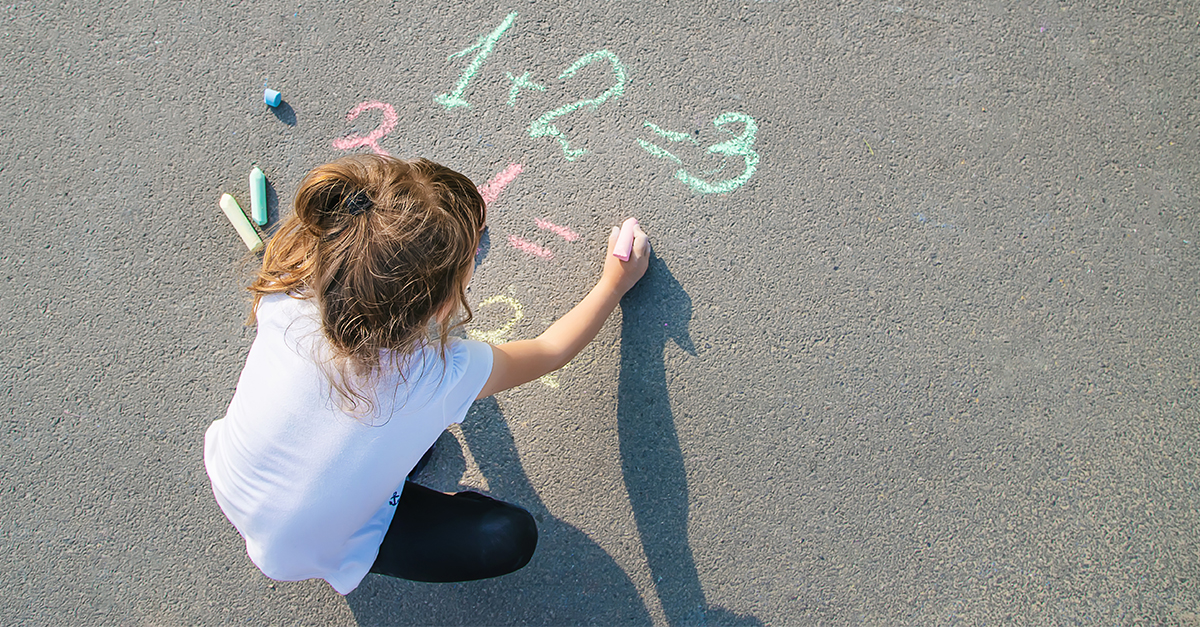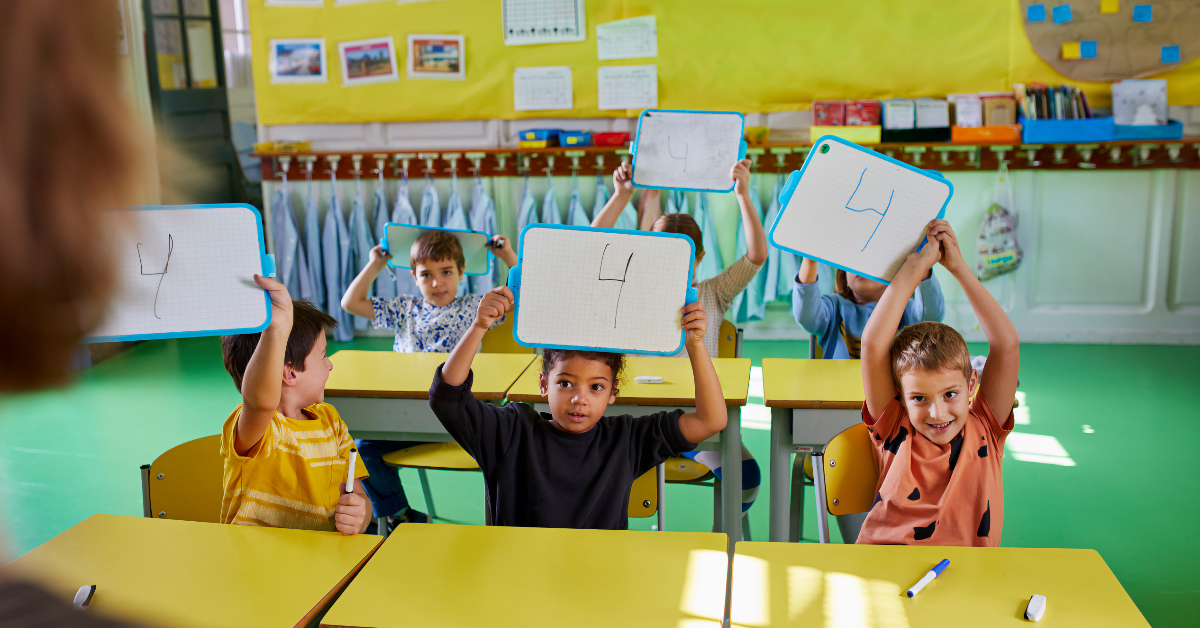As the school year winds down, parents face the question of how to keep math thinking alive during the off-months. Before we get to the summer math activities and games, we should think about the bigger picture. A creative bridge between your accomplishments of this year to the beginning of the next provides an opportunity for a successful transition in those early back-to-school weeks.
Be Honest with Yourself
Create a strategy that you will be able to follow through with. Remember that you are on a school break as well.
Keep formal academic practice brief. For example, if your student spent the end of the school year learning multi-digit multiplication, put one problem on a wipe-off board daily to keep the process fresh.
Evaluate What You Worked on Last Year
What might still be a little fuzzy? You may find that consistently spending five minutes on practice a few times a week will serve your student well and keep them from needing to relearn the same concepts in the fall. Keep your child’s hard-earned learning from slipping.
Here are a few summer math activities and summer math games to keep your child’s math skills sharp during the summer months.

4 Summer Math Activities
1) Explore Math Concepts with Math Manipulatives
If your child starts math for the first time in the fall, allow them to explore math concepts with math manipulatives, like the Math-U-See® integer blocks, in preparation.
Get the blocks out every few days and try different activities, such as sorting them by color or size. Allow your child to create shapes or extend simple patterns with the blocks. Benefits (besides fun) are readiness for learning math facts and problem-solving.
2) Go to the Library
Check out your local library for great children’s books with a mathematical theme. These books present math ideas in fun ways and can help your child see the big picture. Some read-aloud recommendations include:
- The Icky Bug Counting Book by Jerry Pallotta
- Ten Little Ladybugs by Melanie Gerth
- Spaghetti and Meatballs for All! by Marilyn Burns
- A Remainder of One by Elinor J. Pinczes
- The Grapes of Math by Greg Tang
- A Place for Zero: A Math Adventure by Angeline Sparagna LoPresti
- Sir Cumference and the First Round Table by Cindy Neuschwander
Your library may also have a reading challenge that you can participate in.
3) Add Puzzles to the Mix
These could be anything from formal puzzles to life situations that invoke moments of pausing and gathering what we know to solve what we do not know. Confidence in this reasoning will significantly benefit them as they move into higher mathematical thinking. Math and puzzles go hand in hand. As you enjoy your vacation, look for opportunities to solve situations that naturally arise with a simple problem-solving conversation that starts, “Ok, what DO we know?”
4) Look at Art
Math concepts have several connections to art, and appreciation can go both ways. These connections include perspective, ratio, angle, line, balance, and graphing.
You could visit a farm or gardens, which consist of rows. These activities might be a single discovery day, or you can make it a multi-day/summer project. While there, pause and observe what you see and know. Gather clues. What size are the plants right in front of you? How about 20 feet away? They look smaller, but are they? Is there a point where all the rows seem to combine and become one or vanish? See if you can find the natural horizon line. Focus on what color(s) are there.

5 Summer Math Games
Summer offers parents and preschoolers time to enjoy the outdoors while stretching their brain muscles. The outdoor environment provides endless opportunities to build upon your child’s mathematical skills. Together, you can explore numbers, shapes, measurements, and more by trying some of these fun and easy guided activities or by simply asking the right questions to engage your child in talking about math.
1) Have a Ball!
Gather a variety of balls (football, basketball, soccer ball, golf ball, bouncy ball, ping pong ball, baseball, etc.) and place them in a box or laundry basket. Have your child sort, order, weigh, and count the balls. He can also experiment with positions (in, out, around, on, under, etc.) as he places the balls in relation to another object, such as a table or chair.
2) Number Walks
Write a number on an index card and stick it to a container, such as a wagon, bucket, or paper bag. The object of the game is for your child to place the same number of items in the container as the number on the card. When she has the correct number of items, she can show you and then replace the items back where they belong. When replacing the items, encourage her to count backward. As an extension, you can have your child look for groups of similar objects.
3) Spray It!
Draw at least ten numbers or shapes with sidewalk chalk in a designated area. Given your child’s skill and comfort level, the number of shapes drawn can be increased or decreased. Give your child a spray bottle filled with water. To play, ask your child to find a particular number, shape, or to find the answer to a math fact. When he finds it, he sprays it! Variations of this might include finding even or odd numbers, skip counting, counting backward, finding shapes with the same number of sides, or finding a shape with a given number of sides. As an alternative to using a spray bottle, your child might enjoy using a flyswatter, wet sponge, or duster.
4) Fraction Hopscotch
Head outside and draw a hopscotch board. Ask your child to stand on zero and toss a coin or pebble onto a fraction. As they hop, they are to say each fraction. If they land on a double, they must name the equivalent fractions. If there are three squares, straddle it and say each fraction, then jump, do a half twist in the air, and land with both feet on the center fraction. Variations of the game might include mixing up the order the fractions that appear on the board and hopping on fractions with common denominators, equivalent fractions, or in order from least to greatest (or greatest to least).
5) Math Relay
Make up cards ahead of time for different math skills. For instance, changing a fraction to a percentage or multiplication and division facts. If you have multiple children at different skill levels, you can color-code the cards based on the skill you want them to practice. Draw a line with sidewalk chalk with the words “Ready, Go!” written beneath it. Draw a second line approximately 8 to 10 yards away with the words “Stop, Solve, and Sprint.” Place the math cards with the problems at this line with some sidewalk chalk. Have your child begin at the “Ready, Go!” line while you wait at the “Stop, Solve, and Sprint” line. When your child hears, “Ready, Go!” they sprint to the other line, solve a math problem, have you verify the answer, and sprint back to the start line where they either take a short break or they tag the next child in the relay to complete a problem. Repeat for several rounds.
With some creativity and minimal effort, your student’s math skills can be kept fresh and ready to go all with these summer math activities and games! The most important thing is to enjoy your time together this summer.
We Are Here to Help
If you have questions about teaching math, we are here to help!
Get in Touch



Leave a Reply